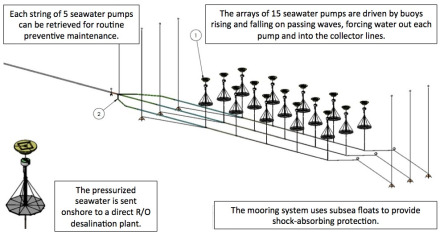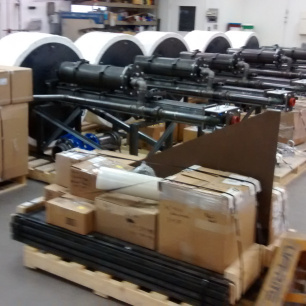 As waves pass under the array (as seen here to the right), the buoys rise. A series of free-floating platforms called Variable Sea Anchors or “VSAs” are connected beneath the pump and provide drag to the rising buoys. The pumps located between the VSA and buoy are designed to take advantage of the resulting tension to pull in sea water and pump it towards shore. The entire array acts in series with five pumps along three separate strings to increase the volume and pressure of water being delivered on shore through a central pipe. The seawater is then run through an R/O system that takes advantage of the arriving pressure to desalinate the seawater with no external energy input. Pressurized seawater can also be directed to land based aquaculture. As Atmocean reaches economy of scale and realizes additional efficiency, future arrays could be used for power production with pressurized water going through a simple Pelton water wheel to generate renewable electricity.
As waves pass under the array (as seen here to the right), the buoys rise. A series of free-floating platforms called Variable Sea Anchors or “VSAs” are connected beneath the pump and provide drag to the rising buoys. The pumps located between the VSA and buoy are designed to take advantage of the resulting tension to pull in sea water and pump it towards shore. The entire array acts in series with five pumps along three separate strings to increase the volume and pressure of water being delivered on shore through a central pipe. The seawater is then run through an R/O system that takes advantage of the arriving pressure to desalinate the seawater with no external energy input. Pressurized seawater can also be directed to land based aquaculture. As Atmocean reaches economy of scale and realizes additional efficiency, future arrays could be used for power production with pressurized water going through a simple Pelton water wheel to generate renewable electricity.

As with any renewable energy, we are not constrained by how fast we can dig and burn coal, but the motion of the oceans. Our system requires a minimum of 1m wave height to operate and will operate at a maximum of 3m wave height. Buoys will submerge in waves greater than 3m, acting as a self-protection mechanism while still using the maximum pump stroke of 3m.
Atmocean’s system acts to generate clean fresh water, leading to the reduction of dependence on fossil fuels while benefiting the environment by reducing CO2 emissions. It is an ideal export product, able to be shipped in standard shipping containers or manufactured locally, generating thousands of new jobs in the countries we enter.
